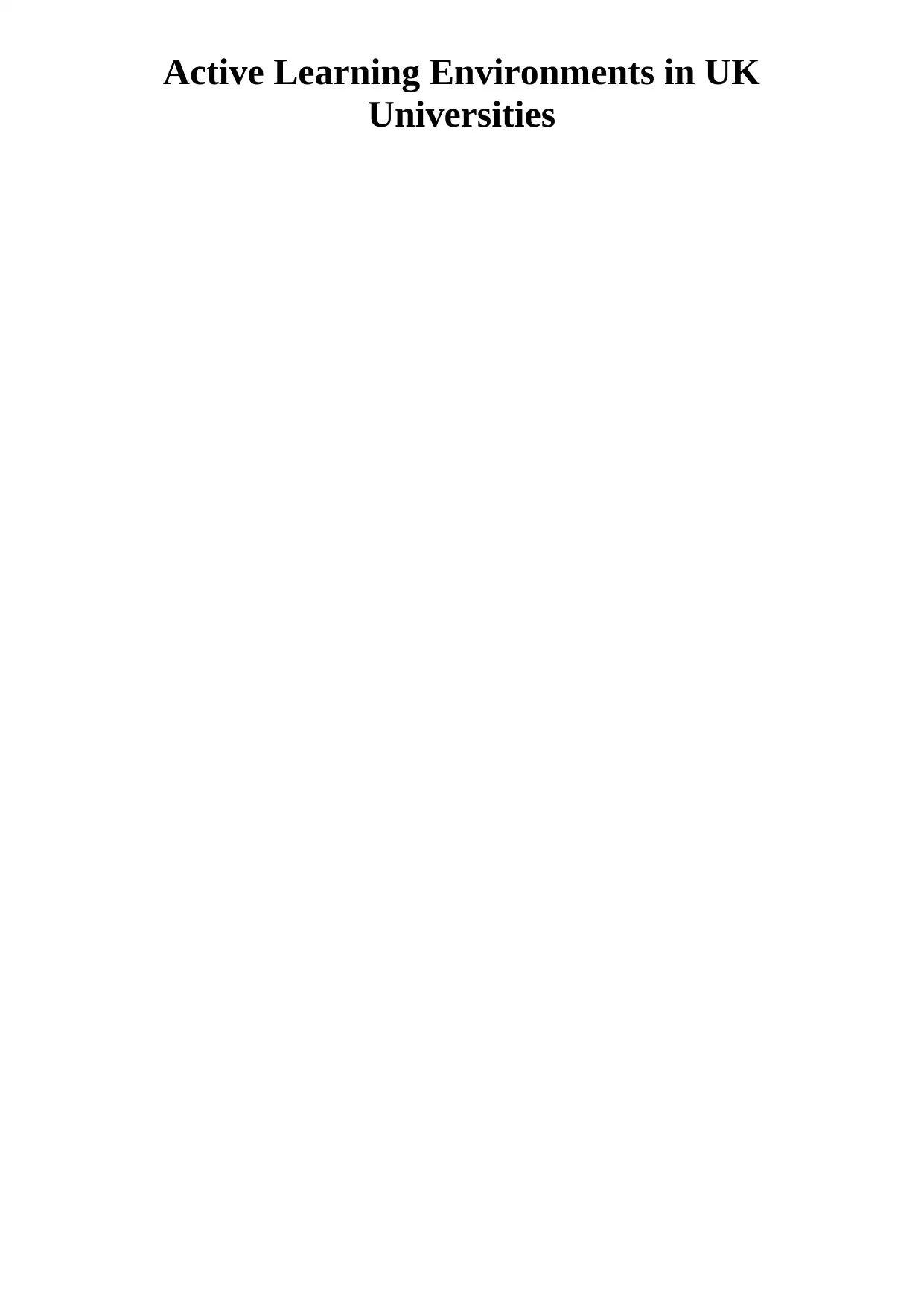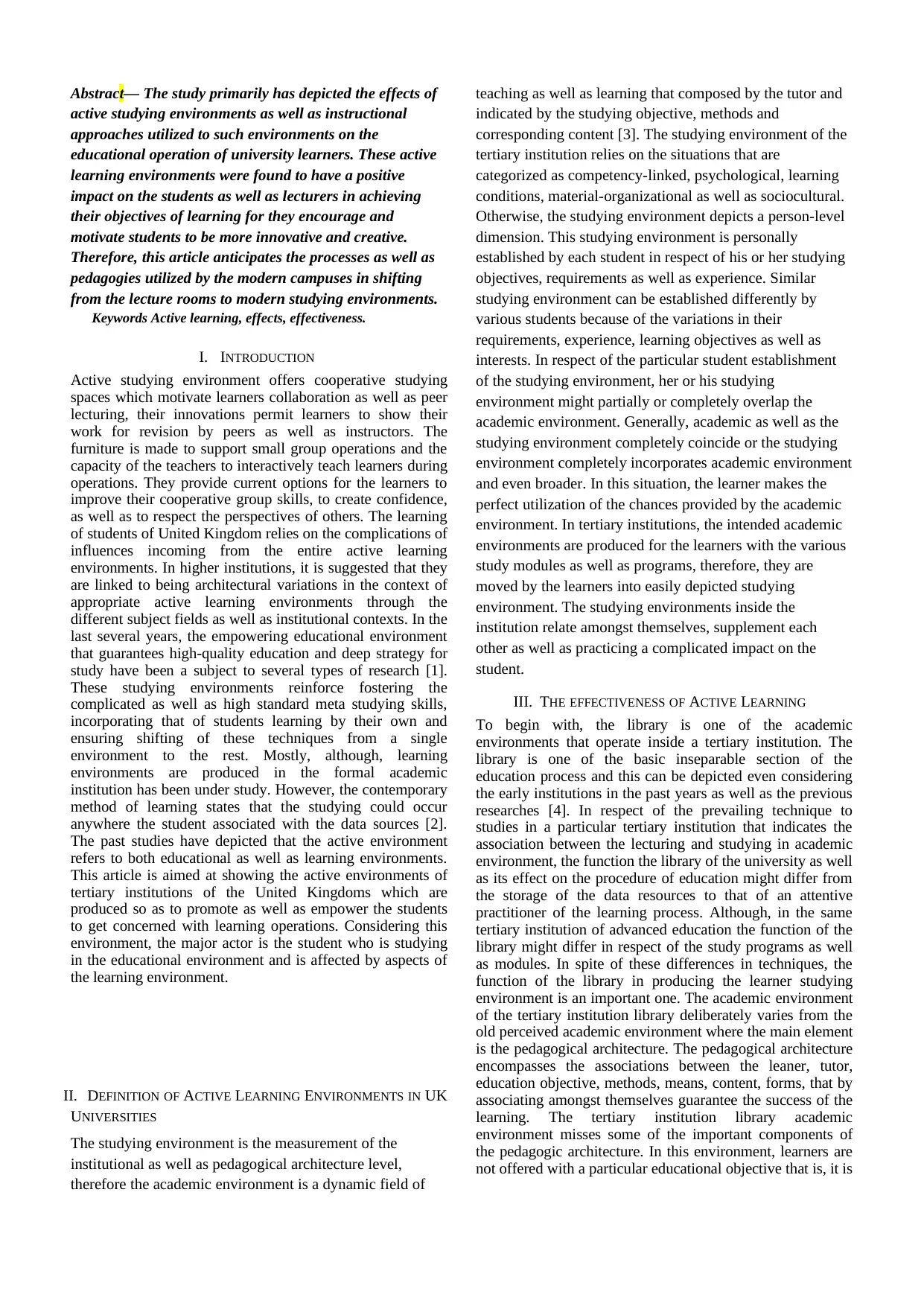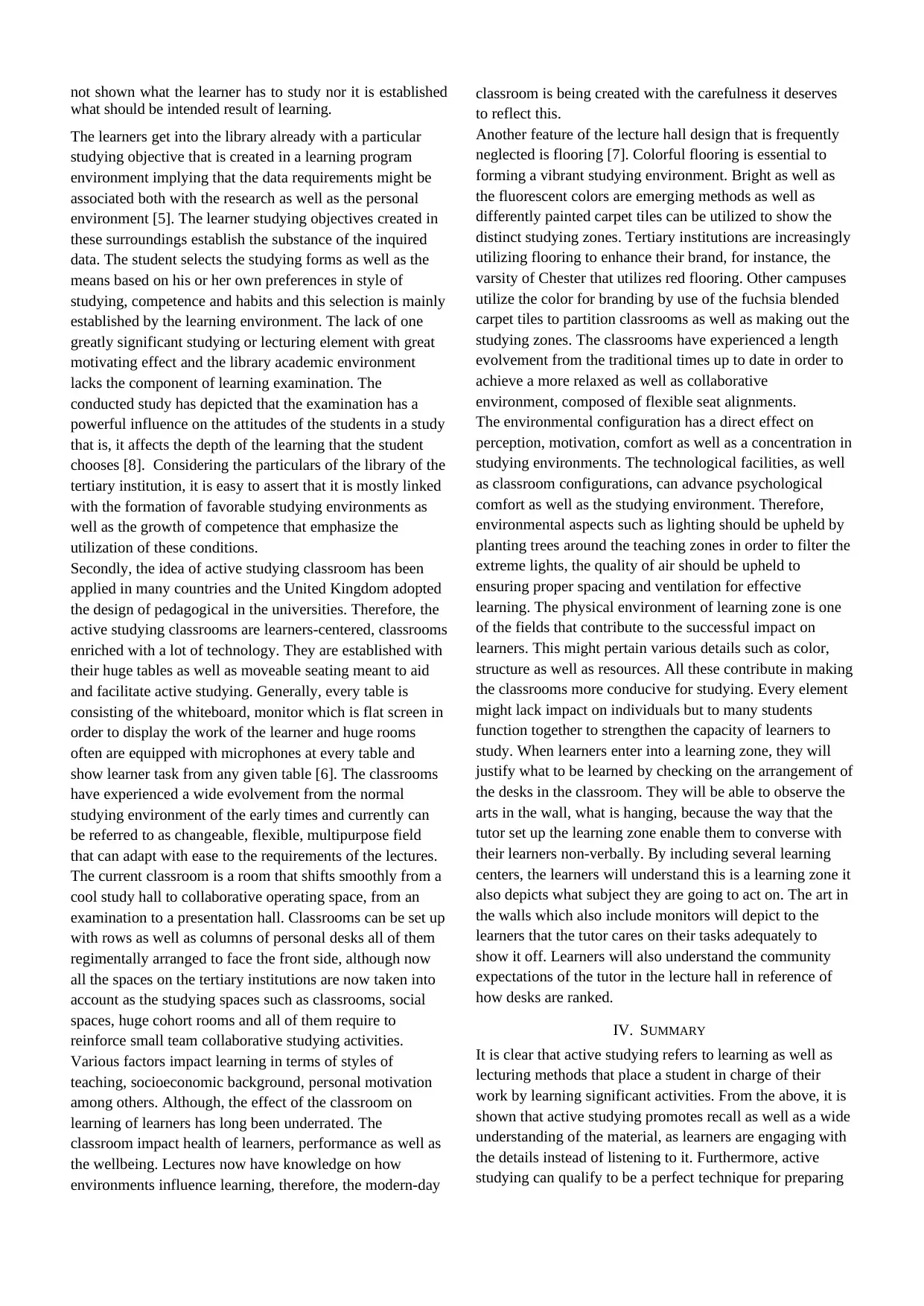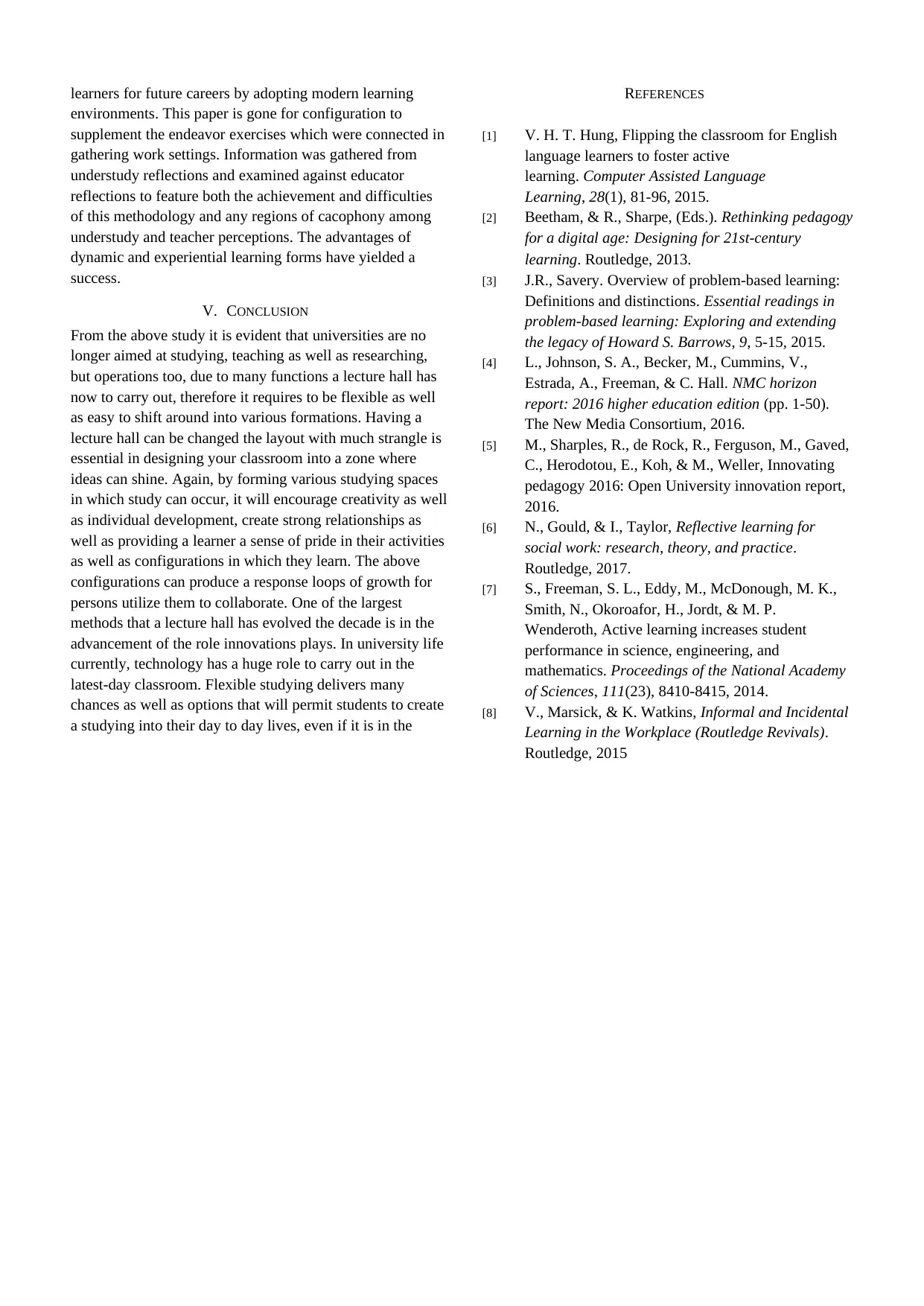Active Learning Environments in UK Universities
VerifiedAdded on 2023/05/31
|5
|2658
|353
AI Summary
This study explores the impact of active learning environments on the educational performance of university students in the UK. It discusses the definition of active learning environments, their effectiveness, and the design of modern classrooms.
Contribute Materials
Your contribution can guide someone’s learning journey. Share your
documents today.

Active Learning Environments in UK
Universities
Universities
Secure Best Marks with AI Grader
Need help grading? Try our AI Grader for instant feedback on your assignments.

Abstract— The study primarily has depicted the effects of
active studying environments as well as instructional
approaches utilized to such environments on the
educational operation of university learners. These active
learning environments were found to have a positive
impact on the students as well as lecturers in achieving
their objectives of learning for they encourage and
motivate students to be more innovative and creative.
Therefore, this article anticipates the processes as well as
pedagogies utilized by the modern campuses in shifting
from the lecture rooms to modern studying environments.
Keywords Active learning, effects, effectiveness.
I. INTRODUCTION
Active studying environment offers cooperative studying
spaces which motivate learners collaboration as well as peer
lecturing, their innovations permit learners to show their
work for revision by peers as well as instructors. The
furniture is made to support small group operations and the
capacity of the teachers to interactively teach learners during
operations. They provide current options for the learners to
improve their cooperative group skills, to create confidence,
as well as to respect the perspectives of others. The learning
of students of United Kingdom relies on the complications of
influences incoming from the entire active learning
environments. In higher institutions, it is suggested that they
are linked to being architectural variations in the context of
appropriate active learning environments through the
different subject fields as well as institutional contexts. In the
last several years, the empowering educational environment
that guarantees high-quality education and deep strategy for
study have been a subject to several types of research [1].
These studying environments reinforce fostering the
complicated as well as high standard meta studying skills,
incorporating that of students learning by their own and
ensuring shifting of these techniques from a single
environment to the rest. Mostly, although, learning
environments are produced in the formal academic
institution has been under study. However, the contemporary
method of learning states that the studying could occur
anywhere the student associated with the data sources [2].
The past studies have depicted that the active environment
refers to both educational as well as learning environments.
This article is aimed at showing the active environments of
tertiary institutions of the United Kingdoms which are
produced so as to promote as well as empower the students
to get concerned with learning operations. Considering this
environment, the major actor is the student who is studying
in the educational environment and is affected by aspects of
the learning environment.
II. DEFINITION OF ACTIVE LEARNING ENVIRONMENTS IN UK
UNIVERSITIES
The studying environment is the measurement of the
institutional as well as pedagogical architecture level,
therefore the academic environment is a dynamic field of
teaching as well as learning that composed by the tutor and
indicated by the studying objective, methods and
corresponding content [3]. The studying environment of the
tertiary institution relies on the situations that are
categorized as competency-linked, psychological, learning
conditions, material-organizational as well as sociocultural.
Otherwise, the studying environment depicts a person-level
dimension. This studying environment is personally
established by each student in respect of his or her studying
objectives, requirements as well as experience. Similar
studying environment can be established differently by
various students because of the variations in their
requirements, experience, learning objectives as well as
interests. In respect of the particular student establishment
of the studying environment, her or his studying
environment might partially or completely overlap the
academic environment. Generally, academic as well as the
studying environment completely coincide or the studying
environment completely incorporates academic environment
and even broader. In this situation, the learner makes the
perfect utilization of the chances provided by the academic
environment. In tertiary institutions, the intended academic
environments are produced for the learners with the various
study modules as well as programs, therefore, they are
moved by the learners into easily depicted studying
environment. The studying environments inside the
institution relate amongst themselves, supplement each
other as well as practicing a complicated impact on the
student.
III. THE EFFECTIVENESS OF ACTIVE LEARNING
To begin with, the library is one of the academic
environments that operate inside a tertiary institution. The
library is one of the basic inseparable section of the
education process and this can be depicted even considering
the early institutions in the past years as well as the previous
researches [4]. In respect of the prevailing technique to
studies in a particular tertiary institution that indicates the
association between the lecturing and studying in academic
environment, the function the library of the university as well
as its effect on the procedure of education might differ from
the storage of the data resources to that of an attentive
practitioner of the learning process. Although, in the same
tertiary institution of advanced education the function of the
library might differ in respect of the study programs as well
as modules. In spite of these differences in techniques, the
function of the library in producing the learner studying
environment is an important one. The academic environment
of the tertiary institution library deliberately varies from the
old perceived academic environment where the main element
is the pedagogical architecture. The pedagogical architecture
encompasses the associations between the leaner, tutor,
education objective, methods, means, content, forms, that by
associating amongst themselves guarantee the success of the
learning. The tertiary institution library academic
environment misses some of the important components of
the pedagogic architecture. In this environment, learners are
not offered with a particular educational objective that is, it is
active studying environments as well as instructional
approaches utilized to such environments on the
educational operation of university learners. These active
learning environments were found to have a positive
impact on the students as well as lecturers in achieving
their objectives of learning for they encourage and
motivate students to be more innovative and creative.
Therefore, this article anticipates the processes as well as
pedagogies utilized by the modern campuses in shifting
from the lecture rooms to modern studying environments.
Keywords Active learning, effects, effectiveness.
I. INTRODUCTION
Active studying environment offers cooperative studying
spaces which motivate learners collaboration as well as peer
lecturing, their innovations permit learners to show their
work for revision by peers as well as instructors. The
furniture is made to support small group operations and the
capacity of the teachers to interactively teach learners during
operations. They provide current options for the learners to
improve their cooperative group skills, to create confidence,
as well as to respect the perspectives of others. The learning
of students of United Kingdom relies on the complications of
influences incoming from the entire active learning
environments. In higher institutions, it is suggested that they
are linked to being architectural variations in the context of
appropriate active learning environments through the
different subject fields as well as institutional contexts. In the
last several years, the empowering educational environment
that guarantees high-quality education and deep strategy for
study have been a subject to several types of research [1].
These studying environments reinforce fostering the
complicated as well as high standard meta studying skills,
incorporating that of students learning by their own and
ensuring shifting of these techniques from a single
environment to the rest. Mostly, although, learning
environments are produced in the formal academic
institution has been under study. However, the contemporary
method of learning states that the studying could occur
anywhere the student associated with the data sources [2].
The past studies have depicted that the active environment
refers to both educational as well as learning environments.
This article is aimed at showing the active environments of
tertiary institutions of the United Kingdoms which are
produced so as to promote as well as empower the students
to get concerned with learning operations. Considering this
environment, the major actor is the student who is studying
in the educational environment and is affected by aspects of
the learning environment.
II. DEFINITION OF ACTIVE LEARNING ENVIRONMENTS IN UK
UNIVERSITIES
The studying environment is the measurement of the
institutional as well as pedagogical architecture level,
therefore the academic environment is a dynamic field of
teaching as well as learning that composed by the tutor and
indicated by the studying objective, methods and
corresponding content [3]. The studying environment of the
tertiary institution relies on the situations that are
categorized as competency-linked, psychological, learning
conditions, material-organizational as well as sociocultural.
Otherwise, the studying environment depicts a person-level
dimension. This studying environment is personally
established by each student in respect of his or her studying
objectives, requirements as well as experience. Similar
studying environment can be established differently by
various students because of the variations in their
requirements, experience, learning objectives as well as
interests. In respect of the particular student establishment
of the studying environment, her or his studying
environment might partially or completely overlap the
academic environment. Generally, academic as well as the
studying environment completely coincide or the studying
environment completely incorporates academic environment
and even broader. In this situation, the learner makes the
perfect utilization of the chances provided by the academic
environment. In tertiary institutions, the intended academic
environments are produced for the learners with the various
study modules as well as programs, therefore, they are
moved by the learners into easily depicted studying
environment. The studying environments inside the
institution relate amongst themselves, supplement each
other as well as practicing a complicated impact on the
student.
III. THE EFFECTIVENESS OF ACTIVE LEARNING
To begin with, the library is one of the academic
environments that operate inside a tertiary institution. The
library is one of the basic inseparable section of the
education process and this can be depicted even considering
the early institutions in the past years as well as the previous
researches [4]. In respect of the prevailing technique to
studies in a particular tertiary institution that indicates the
association between the lecturing and studying in academic
environment, the function the library of the university as well
as its effect on the procedure of education might differ from
the storage of the data resources to that of an attentive
practitioner of the learning process. Although, in the same
tertiary institution of advanced education the function of the
library might differ in respect of the study programs as well
as modules. In spite of these differences in techniques, the
function of the library in producing the learner studying
environment is an important one. The academic environment
of the tertiary institution library deliberately varies from the
old perceived academic environment where the main element
is the pedagogical architecture. The pedagogical architecture
encompasses the associations between the leaner, tutor,
education objective, methods, means, content, forms, that by
associating amongst themselves guarantee the success of the
learning. The tertiary institution library academic
environment misses some of the important components of
the pedagogic architecture. In this environment, learners are
not offered with a particular educational objective that is, it is

not shown what the learner has to study nor it is established
what should be intended result of learning.
The learners get into the library already with a particular
studying objective that is created in a learning program
environment implying that the data requirements might be
associated both with the research as well as the personal
environment [5]. The learner studying objectives created in
these surroundings establish the substance of the inquired
data. The student selects the studying forms as well as the
means based on his or her own preferences in style of
studying, competence and habits and this selection is mainly
established by the learning environment. The lack of one
greatly significant studying or lecturing element with great
motivating effect and the library academic environment
lacks the component of learning examination. The
conducted study has depicted that the examination has a
powerful influence on the attitudes of the students in a study
that is, it affects the depth of the learning that the student
chooses [8]. Considering the particulars of the library of the
tertiary institution, it is easy to assert that it is mostly linked
with the formation of favorable studying environments as
well as the growth of competence that emphasize the
utilization of these conditions.
Secondly, the idea of active studying classroom has been
applied in many countries and the United Kingdom adopted
the design of pedagogical in the universities. Therefore, the
active studying classrooms are learners-centered, classrooms
enriched with a lot of technology. They are established with
their huge tables as well as moveable seating meant to aid
and facilitate active studying. Generally, every table is
consisting of the whiteboard, monitor which is flat screen in
order to display the work of the learner and huge rooms
often are equipped with microphones at every table and
show learner task from any given table [6]. The classrooms
have experienced a wide evolvement from the normal
studying environment of the early times and currently can
be referred to as changeable, flexible, multipurpose field
that can adapt with ease to the requirements of the lectures.
The current classroom is a room that shifts smoothly from a
cool study hall to collaborative operating space, from an
examination to a presentation hall. Classrooms can be set up
with rows as well as columns of personal desks all of them
regimentally arranged to face the front side, although now
all the spaces on the tertiary institutions are now taken into
account as the studying spaces such as classrooms, social
spaces, huge cohort rooms and all of them require to
reinforce small team collaborative studying activities.
Various factors impact learning in terms of styles of
teaching, socioeconomic background, personal motivation
among others. Although, the effect of the classroom on
learning of learners has long been underrated. The
classroom impact health of learners, performance as well as
the wellbeing. Lectures now have knowledge on how
environments influence learning, therefore, the modern-day
classroom is being created with the carefulness it deserves
to reflect this.
Another feature of the lecture hall design that is frequently
neglected is flooring [7]. Colorful flooring is essential to
forming a vibrant studying environment. Bright as well as
the fluorescent colors are emerging methods as well as
differently painted carpet tiles can be utilized to show the
distinct studying zones. Tertiary institutions are increasingly
utilizing flooring to enhance their brand, for instance, the
varsity of Chester that utilizes red flooring. Other campuses
utilize the color for branding by use of the fuchsia blended
carpet tiles to partition classrooms as well as making out the
studying zones. The classrooms have experienced a length
evolvement from the traditional times up to date in order to
achieve a more relaxed as well as collaborative
environment, composed of flexible seat alignments.
The environmental configuration has a direct effect on
perception, motivation, comfort as well as a concentration in
studying environments. The technological facilities, as well
as classroom configurations, can advance psychological
comfort as well as the studying environment. Therefore,
environmental aspects such as lighting should be upheld by
planting trees around the teaching zones in order to filter the
extreme lights, the quality of air should be upheld to
ensuring proper spacing and ventilation for effective
learning. The physical environment of learning zone is one
of the fields that contribute to the successful impact on
learners. This might pertain various details such as color,
structure as well as resources. All these contribute in making
the classrooms more conducive for studying. Every element
might lack impact on individuals but to many students
function together to strengthen the capacity of learners to
study. When learners enter into a learning zone, they will
justify what to be learned by checking on the arrangement of
the desks in the classroom. They will be able to observe the
arts in the wall, what is hanging, because the way that the
tutor set up the learning zone enable them to converse with
their learners non-verbally. By including several learning
centers, the learners will understand this is a learning zone it
also depicts what subject they are going to act on. The art in
the walls which also include monitors will depict to the
learners that the tutor cares on their tasks adequately to
show it off. Learners will also understand the community
expectations of the tutor in the lecture hall in reference of
how desks are ranked.
IV. SUMMARY
It is clear that active studying refers to learning as well as
lecturing methods that place a student in charge of their
work by learning significant activities. From the above, it is
shown that active studying promotes recall as well as a wide
understanding of the material, as learners are engaging with
the details instead of listening to it. Furthermore, active
studying can qualify to be a perfect technique for preparing
what should be intended result of learning.
The learners get into the library already with a particular
studying objective that is created in a learning program
environment implying that the data requirements might be
associated both with the research as well as the personal
environment [5]. The learner studying objectives created in
these surroundings establish the substance of the inquired
data. The student selects the studying forms as well as the
means based on his or her own preferences in style of
studying, competence and habits and this selection is mainly
established by the learning environment. The lack of one
greatly significant studying or lecturing element with great
motivating effect and the library academic environment
lacks the component of learning examination. The
conducted study has depicted that the examination has a
powerful influence on the attitudes of the students in a study
that is, it affects the depth of the learning that the student
chooses [8]. Considering the particulars of the library of the
tertiary institution, it is easy to assert that it is mostly linked
with the formation of favorable studying environments as
well as the growth of competence that emphasize the
utilization of these conditions.
Secondly, the idea of active studying classroom has been
applied in many countries and the United Kingdom adopted
the design of pedagogical in the universities. Therefore, the
active studying classrooms are learners-centered, classrooms
enriched with a lot of technology. They are established with
their huge tables as well as moveable seating meant to aid
and facilitate active studying. Generally, every table is
consisting of the whiteboard, monitor which is flat screen in
order to display the work of the learner and huge rooms
often are equipped with microphones at every table and
show learner task from any given table [6]. The classrooms
have experienced a wide evolvement from the normal
studying environment of the early times and currently can
be referred to as changeable, flexible, multipurpose field
that can adapt with ease to the requirements of the lectures.
The current classroom is a room that shifts smoothly from a
cool study hall to collaborative operating space, from an
examination to a presentation hall. Classrooms can be set up
with rows as well as columns of personal desks all of them
regimentally arranged to face the front side, although now
all the spaces on the tertiary institutions are now taken into
account as the studying spaces such as classrooms, social
spaces, huge cohort rooms and all of them require to
reinforce small team collaborative studying activities.
Various factors impact learning in terms of styles of
teaching, socioeconomic background, personal motivation
among others. Although, the effect of the classroom on
learning of learners has long been underrated. The
classroom impact health of learners, performance as well as
the wellbeing. Lectures now have knowledge on how
environments influence learning, therefore, the modern-day
classroom is being created with the carefulness it deserves
to reflect this.
Another feature of the lecture hall design that is frequently
neglected is flooring [7]. Colorful flooring is essential to
forming a vibrant studying environment. Bright as well as
the fluorescent colors are emerging methods as well as
differently painted carpet tiles can be utilized to show the
distinct studying zones. Tertiary institutions are increasingly
utilizing flooring to enhance their brand, for instance, the
varsity of Chester that utilizes red flooring. Other campuses
utilize the color for branding by use of the fuchsia blended
carpet tiles to partition classrooms as well as making out the
studying zones. The classrooms have experienced a length
evolvement from the traditional times up to date in order to
achieve a more relaxed as well as collaborative
environment, composed of flexible seat alignments.
The environmental configuration has a direct effect on
perception, motivation, comfort as well as a concentration in
studying environments. The technological facilities, as well
as classroom configurations, can advance psychological
comfort as well as the studying environment. Therefore,
environmental aspects such as lighting should be upheld by
planting trees around the teaching zones in order to filter the
extreme lights, the quality of air should be upheld to
ensuring proper spacing and ventilation for effective
learning. The physical environment of learning zone is one
of the fields that contribute to the successful impact on
learners. This might pertain various details such as color,
structure as well as resources. All these contribute in making
the classrooms more conducive for studying. Every element
might lack impact on individuals but to many students
function together to strengthen the capacity of learners to
study. When learners enter into a learning zone, they will
justify what to be learned by checking on the arrangement of
the desks in the classroom. They will be able to observe the
arts in the wall, what is hanging, because the way that the
tutor set up the learning zone enable them to converse with
their learners non-verbally. By including several learning
centers, the learners will understand this is a learning zone it
also depicts what subject they are going to act on. The art in
the walls which also include monitors will depict to the
learners that the tutor cares on their tasks adequately to
show it off. Learners will also understand the community
expectations of the tutor in the lecture hall in reference of
how desks are ranked.
IV. SUMMARY
It is clear that active studying refers to learning as well as
lecturing methods that place a student in charge of their
work by learning significant activities. From the above, it is
shown that active studying promotes recall as well as a wide
understanding of the material, as learners are engaging with
the details instead of listening to it. Furthermore, active
studying can qualify to be a perfect technique for preparing

learners for future careers by adopting modern learning
environments. This paper is gone for configuration to
supplement the endeavor exercises which were connected in
gathering work settings. Information was gathered from
understudy reflections and examined against educator
reflections to feature both the achievement and difficulties
of this methodology and any regions of cacophony among
understudy and teacher perceptions. The advantages of
dynamic and experiential learning forms have yielded a
success.
V. CONCLUSION
From the above study it is evident that universities are no
longer aimed at studying, teaching as well as researching,
but operations too, due to many functions a lecture hall has
now to carry out, therefore it requires to be flexible as well
as easy to shift around into various formations. Having a
lecture hall can be changed the layout with much strangle is
essential in designing your classroom into a zone where
ideas can shine. Again, by forming various studying spaces
in which study can occur, it will encourage creativity as well
as individual development, create strong relationships as
well as providing a learner a sense of pride in their activities
as well as configurations in which they learn. The above
configurations can produce a response loops of growth for
persons utilize them to collaborate. One of the largest
methods that a lecture hall has evolved the decade is in the
advancement of the role innovations plays. In university life
currently, technology has a huge role to carry out in the
latest-day classroom. Flexible studying delivers many
chances as well as options that will permit students to create
a studying into their day to day lives, even if it is in the
REFERENCES
[1] V. H. T. Hung, Flipping the classroom for English
language learners to foster active
learning. Computer Assisted Language
Learning, 28(1), 81-96, 2015.
[2] Beetham, & R., Sharpe, (Eds.). Rethinking pedagogy
for a digital age: Designing for 21st-century
learning. Routledge, 2013.
[3] J.R., Savery. Overview of problem-based learning:
Definitions and distinctions. Essential readings in
problem-based learning: Exploring and extending
the legacy of Howard S. Barrows, 9, 5-15, 2015.
[4] L., Johnson, S. A., Becker, M., Cummins, V.,
Estrada, A., Freeman, & C. Hall. NMC horizon
report: 2016 higher education edition (pp. 1-50).
The New Media Consortium, 2016.
[5] M., Sharples, R., de Rock, R., Ferguson, M., Gaved,
C., Herodotou, E., Koh, & M., Weller, Innovating
pedagogy 2016: Open University innovation report,
2016.
[6] N., Gould, & I., Taylor, Reflective learning for
social work: research, theory, and practice.
Routledge, 2017.
[7] S., Freeman, S. L., Eddy, M., McDonough, M. K.,
Smith, N., Okoroafor, H., Jordt, & M. P.
Wenderoth, Active learning increases student
performance in science, engineering, and
mathematics. Proceedings of the National Academy
of Sciences, 111(23), 8410-8415, 2014.
[8] V., Marsick, & K. Watkins, Informal and Incidental
Learning in the Workplace (Routledge Revivals).
Routledge, 2015
environments. This paper is gone for configuration to
supplement the endeavor exercises which were connected in
gathering work settings. Information was gathered from
understudy reflections and examined against educator
reflections to feature both the achievement and difficulties
of this methodology and any regions of cacophony among
understudy and teacher perceptions. The advantages of
dynamic and experiential learning forms have yielded a
success.
V. CONCLUSION
From the above study it is evident that universities are no
longer aimed at studying, teaching as well as researching,
but operations too, due to many functions a lecture hall has
now to carry out, therefore it requires to be flexible as well
as easy to shift around into various formations. Having a
lecture hall can be changed the layout with much strangle is
essential in designing your classroom into a zone where
ideas can shine. Again, by forming various studying spaces
in which study can occur, it will encourage creativity as well
as individual development, create strong relationships as
well as providing a learner a sense of pride in their activities
as well as configurations in which they learn. The above
configurations can produce a response loops of growth for
persons utilize them to collaborate. One of the largest
methods that a lecture hall has evolved the decade is in the
advancement of the role innovations plays. In university life
currently, technology has a huge role to carry out in the
latest-day classroom. Flexible studying delivers many
chances as well as options that will permit students to create
a studying into their day to day lives, even if it is in the
REFERENCES
[1] V. H. T. Hung, Flipping the classroom for English
language learners to foster active
learning. Computer Assisted Language
Learning, 28(1), 81-96, 2015.
[2] Beetham, & R., Sharpe, (Eds.). Rethinking pedagogy
for a digital age: Designing for 21st-century
learning. Routledge, 2013.
[3] J.R., Savery. Overview of problem-based learning:
Definitions and distinctions. Essential readings in
problem-based learning: Exploring and extending
the legacy of Howard S. Barrows, 9, 5-15, 2015.
[4] L., Johnson, S. A., Becker, M., Cummins, V.,
Estrada, A., Freeman, & C. Hall. NMC horizon
report: 2016 higher education edition (pp. 1-50).
The New Media Consortium, 2016.
[5] M., Sharples, R., de Rock, R., Ferguson, M., Gaved,
C., Herodotou, E., Koh, & M., Weller, Innovating
pedagogy 2016: Open University innovation report,
2016.
[6] N., Gould, & I., Taylor, Reflective learning for
social work: research, theory, and practice.
Routledge, 2017.
[7] S., Freeman, S. L., Eddy, M., McDonough, M. K.,
Smith, N., Okoroafor, H., Jordt, & M. P.
Wenderoth, Active learning increases student
performance in science, engineering, and
mathematics. Proceedings of the National Academy
of Sciences, 111(23), 8410-8415, 2014.
[8] V., Marsick, & K. Watkins, Informal and Incidental
Learning in the Workplace (Routledge Revivals).
Routledge, 2015
Secure Best Marks with AI Grader
Need help grading? Try our AI Grader for instant feedback on your assignments.

1 out of 5
Related Documents
Your All-in-One AI-Powered Toolkit for Academic Success.
+13062052269
info@desklib.com
Available 24*7 on WhatsApp / Email
![[object Object]](/_next/static/media/star-bottom.7253800d.svg)
Unlock your academic potential
© 2024 | Zucol Services PVT LTD | All rights reserved.





